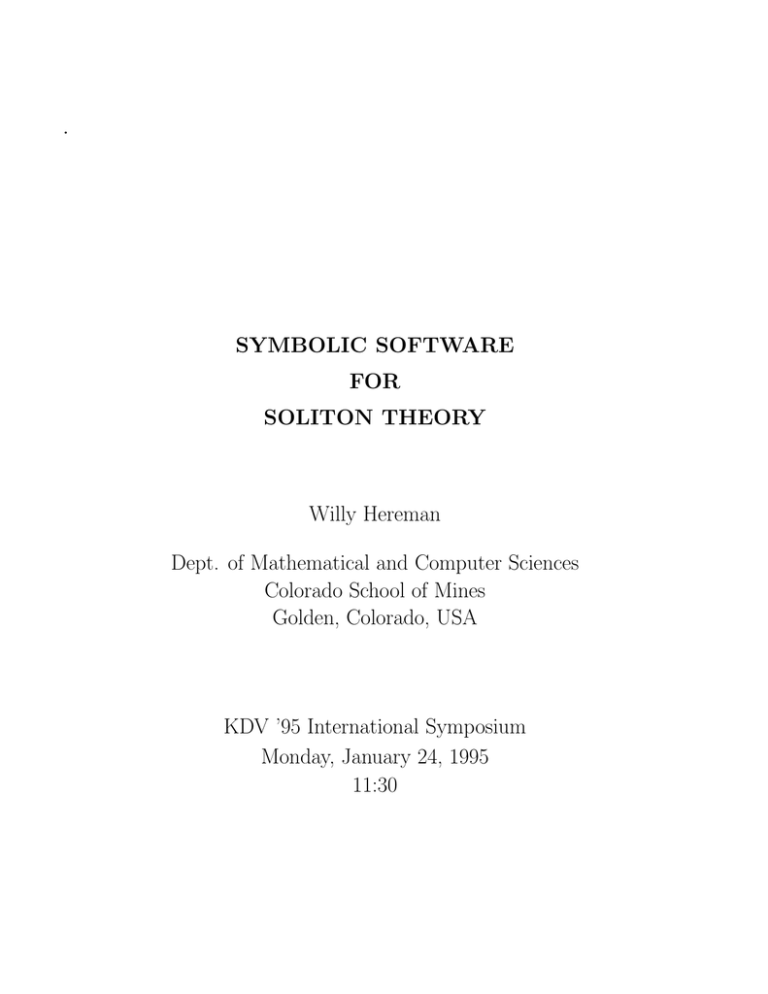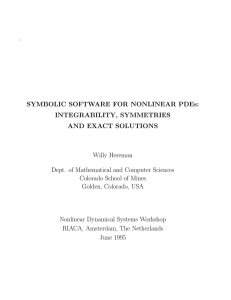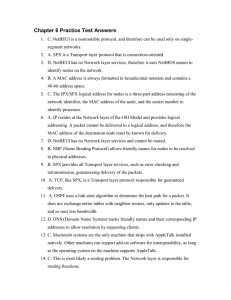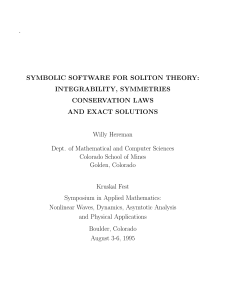.
advertisement

. SYMBOLIC SOFTWARE FOR SOLITON THEORY Willy Hereman Dept. of Mathematical and Computer Sciences Colorado School of Mines Golden, Colorado, USA KDV ’95 International Symposium Monday, January 24, 1995 11:30 I. INTRODUCTION Symbolic Software • Solitons via Hirota’s method (Macsyma & Mathematica) • Painlevé test for ODEs or PDEs (Macsyma) • Conservation laws of PDEs (Mathematica) • Lie symmetries for ODEs and PDEs (Macsyma) Purpose of the programs • Study of integrability of nonlinear PDEs • Exact solutions as bench mark for numerical algorithms • Classification of nonlinear PDEs • Lie symmetries −→ solutions via reductions Collaborators • Ünal Göktaş (MS student) • Chris Elmer (MS student) • Wuning Zhuang (MS student) • Ameina Nuseir (Ph.D student) • Mark Coffey (CU-Boulder) II. FOUR SYMBOLIC PROGRAMS Example 1 – Macsyma/Mathematica Solitons – Hirota’s Method • Hirota’s Direct Method allows to construct soliton solutions of – nonlinear evolution equations – wave equations – coupled systems • Test conditions for existence of soliton solutions • Examples: – Korteweg-de Vries equation (KdV) ut + 6uux + u3x = 0 – Kadomtsev-Petviashvili equation (KP) (ut + 6uux + u3x)x + 3u2y = 0 – Sawada-Kotera equation (SK) ut + 45u2ux + 15uxu2x + 15uu3x + u5x = 0 Hirota’s Method Korteweg-de Vries equation ut + 6uux + u3x = 0 Substitute ∂ 2 ln f (x, t) u(x, t) = 2 ∂x2 Integrate with respect to x 2 f fxt − fxft + f f4x − 4fxf3x + 3f2x =0 Bilinear form def B(f ·f ) = DxDt + Dx4 (f ·f ) = 0 Introduce the bilinear operator m n Dxm Dtn(f ·g) = (∂x − ∂x0) (∂t − ∂t0) f (x, t) g(x0, t0)|x0=x,t0=t Use the expansion f =1+ ∞ X n=1 n fn Substitute f into the bilinear equation Collect powers in (book keeping parameter) O(0) O(1) O(2) O(3) O(4) : : : : : B(1·1) = 0 B(1·f1 + f1·1) = 0 B(1·f2 + f1·f1 + f2·1) = 0 B(1·f3 + f1·f2 + f2·f1 + f3·1) = 0 B(1·f4 + f1·f3 + f2·f2 + f3·f1 + f4·1) = 0 n X n O( ) : B( j=0 fj ·fn−j ) = 0 with f0 = 1 Start with f1 = N X i=1 exp(θi) = N X i=1 exp (ki x − ωi t + δi) ki, ωi and δi are constants Dispersion law ωi = ki3 (i = 1, 2, ..., N ) If the original PDE admits a N-soliton solution then the expansion will truncate at level n = N Consider the case N=3 Terms generated by B(f1, f1) determine f2 = = + + a12 a12 a13 a23 exp(θ1 + θ2) + a13 exp(θ1 + θ3) + a23 exp(θ2 + θ3) exp [(k1 + k2) x − (ω1 + ω2) t + (δ1 + δ2)] exp [(k1 + k3) x − (ω1 + ω3) t + (δ1 + δ3)] exp [(k2 + k3) x − (ω2 + ω3) t + (δ2 + δ3)] Calculate the constants a12, a13 and a23 (ki − kj )2 i, j = 1, 2, 3 aij = 2 (ki + kj ) Terms from B(f1·f2 + f2·f1) determine f3 = b123 exp(θ1 + θ2 + θ3) = b123 exp [(k1 +k2 +k3)x−(ω1 +ω2 +ω3)t+(δ1 +δ2 +δ3)] with (k1 − k2)2 (k1 − k3)2 (k2 − k3)2 b123 = a12 a13 a23 = (k1 + k2)2 (k1 + k3)2 (k2 + k3)2 Subsequently, fi = 0 for i > 3 Set = 1 f = 1 + exp θ1 + exp θ2 + exp θ3 + a12 exp(θ1 + θ2) + a13 exp(θ1 + θ3) + a23 exp(θ2 + θ3) + b123 exp(θ1 + θ2 + θ3) Return to the original u(x, t) ∂ 2 ln f (x, t) u(x, t) = 2 ∂x2 Single soliton solution f = 1 + eθ , θ = kx − ωt + δ k, ω and δ are constants and ω = k 3 Substituting f into ∂ 2 ln f (x, t) u(x, t) = 2 ∂x2 fxxf − fx2 ) = 2( f2 Take k = 2K u = 2K 2sech2K(x − 4K 2t + δ) Two-soliton solution f = 1 + eθ1 + eθ2 + a12eθ1+θ2 θi = kix − ωit + δi with ωi = ki3 , (i = 1, 2) and a12 = (k1 −k2 )2 (k1 +k2 )2 Select eδi c2i kix−ωit+∆i = e ki 1 − 1 (θ̃1+θ̃2) ˜ f = fe 2 4 θ̃i = kix − ωit + ∆i k + k1 2 2 ki ci = k2 − k1 Return to u(x, t) ∂ 2 ln f˜(x, t) u(x, t) = ũ(x, t) = 2 ∂x2 2 k2 = − 2 k22cosech2 θ̃22 + k12sech2 θ̃21 θ̃2 θ̃1 2 (k2 coth 2 − k1 tanh 2 ) k12 HIROTA’S CONDITIONS Single Bilinear equation P (Dx, Dt)(f ·f ) = 0 P is an arbitrary polynomial Example: KdV equation P (Dx, Dt) = DxDt + Dx4 If P satisfies P (Dx, Dt) = P (−Dx, −Dt) P (0, 0) = 0 then the equation always has a two-soliton solution • For 2-soliton solution of KdV equation f = 1 + eθ1 + eθ2 + a12eθ1+θ2 θi = kix − ωit + δi P (ki, −ωi) = 0 or ωi = ki3 , i = 1, 2 P (k1 − k2, −ω1 + ω2) (k1 − k2)2 = a12 = − P (k1 + k2, −ω1 − ω2) (k1 + k2)2 • For the general N -soliton solution f= X µ=0,1 (N ) X exp i<j Aij µiµj + N X i=1 µiθi P (ki − kj , −ωi + ωj ) aij = exp Aij = − P (ki + kj , −ωi − ωj ) Additional condition for P (Dx, Dt) S[P, n] = × X σ=±1 (n) Y i<j P n X i=1 σiki, − n X i=1 σiωi P (σiki − σj kj , −σiωi + σj ωj )σiσj = 0 , for n = 2, . . . , N Special Features of the Programs • Expressions for Hirota’s bilinear operators Dxn(f ·g) (−1)(n−j)n! ∂ j f ∂ n−j g = j=0 j!(n − j)! ∂xj ∂xn−j n X DxmDtn(f ·g) = m X n (−1)(m+n−j−i) m!n! ∂ i+j f ∂ n+m−i−j g X j=0 i=0 j!(m − j)!i!(n − i)!∂ti ∂xj∂tn−i ∂xm−j • Exponential functions h(x, t) = exp(kx − ωt + δ) are never introduced, they are defined via gradef ∂h(x, t) = kh(x, t) ∂x ∂h(x, t) = −ωh(x, t) ∂t • Test for existence of soliton solutions uses random numbers • Symbolic test is available (may be slow) Macsyma and Mathematica Programs The user provides • the bilinear operator B • N for n-soliton solution • number of random tests for 3-soliton solution • symbolic test for 3-soliton solution (true or false) • number of random tests for 4-soliton solution • symbolic test for 4-soliton solution (true or false) The symbolic programs calculates • conditions for existence of up to a 4-soliton solution • the one-, two- and three- soliton solutions • aij and b123 in factored form • the function f, so that u(x, t) can be computed Example 2 – Macsyma/Mathematica Painlevé Integrability Test • Painlevé test for 3rd order equations by Hajee (Reduce, 1982) • Painlevé program (parts) by Hlavatý (Reduce, 1986) • ODE Painlevé by Winternitz & Rand (Macsyma, 1986) • PDE Painlevé by Hereman & Van den Bulck (Macsyma, 1987) • Painlevé test by Conte & Musette (AMP, 1988) • Painlevé analysis by Renner (Reduce, 1992) • Painlevé test for simple systems by Hereman, Elmer and Göktaş (Macsyma, 1994-96, under development) Example 3 - Mathematica Conserved Densities • Purpose Compute polynomial-type conservation laws of single PDEs and systems of PDEs Conservation law: ρt + J x = 0 both ρ(u, ux, u2x, . . . , unx) and J(u, ux, u2x, . . . , unx) Consequently P = +∞ −∞ ρdx Z = constant provided J vanishes at infinity Compare with constants of motions in classical mechanics • Example Consider the KdV equation ut + uux + u3x = 0 Conserved densities: ρ1 = u ρ2 = u2 ρ3 .. ρ6 = u3 − 3u2x .. = u6 − 60u3u2x − 30u4x + 108u2u22x 648 2 216 2 720 3 u2x − uu3x + u4x + 7 7 7 Integrable equations have ∞ conservation laws • Algorithm and Implementation Consider the scaling (weights) of the KdV ∂2 u ∼ 2, ∂x ∂ ∂3 ∼ 3 ∂t ∂x Compute building blocks of ρ3 (i) Start with building block u3 Divide by u and differentiate twice (u2)2x Produces the list of terms [u2x, uu2x] −→ [u2x] Second list: remove terms that are total derivative with respect to x or total derivative up to terms earlier in the list Divide by u2 and differentiate twice (u)4x Produces the list: [u4x] −→ [ ] [ ] is the empty list Gather the terms: ρ3 = u3 + c[1]u2x where the constant c1 must be determined ∂ρ3 = 3u2ut + 2c1uxuxt (ii) Compute ∂t Replace ut by −(uux + uxxx) and uxt by −(uux + uxxx)x (iii) Integrate the result with respect to x Carry out all integrations by parts ∂ρ3 3 4 = −[ u + (c1 −3)uu2x + 3u2uxx − c1u2xx + 2c1uxuxxx]x ∂t 4 −(c1 + 3)u3x The last non-integrable term must vanish Thus, c1 = −3 Result: ρ3 = u3 − 3u2x (iv) Expression [. . .] yields 3 4 J3 = u − 6uu2x + 3u2uxx + 3u2xx − 6uxuxxx 4 Computer building blocks of ρ6 (i) Start with u6 Divide by u and differentiate twice (u5)2x produces the list of terms [u3u2x, u4u2x] −→ [u3u2x] Next, divide u6 by u2, and compute (u4)4x Corresponding list: [u4x, uu2xu2x, u2u22x, u2uxu3x, u3u4x] −→ [u4x, u2u22x] 6 6 Proceed with ( uu3 )6x = (u3)6x, ( uu4 )8x = (u2)8x and u6 ( u5 )10x = (u)10x Obtain the lists: [u32x, uxu2xu3x, uu23x, u2xu4x, uu2xu4x, uuxu5x, u2u6x] −→ [u32x, uu23x] [u24x, u3xu5x, u2xu6x, uxu7x, uu8x] −→ [u24x] and [u10x] −→ [ ] Gather the terms: ρ6 = u6 + c1u3u2x + c2u4x + c3u2u22x + c4u32x + c5uu23x + c6u24x where the constants ci must be determined (ii) Compute ∂ ∂t ρ6 Replace ut, uxt, . . . , unx,t by −(uux + uxxx), . . . (iii) Integrate the result with respect to x Carry out all integrations by parts Require that non-integrabe part vanishes Set to zero all the coefficients of the independent combinations involving powers of u and its derivatives with respect to x Solve the linear system for unknowns c1, c2, . . . , c6 Result: ρ6 = u6 − 60u3u2x − 30u4x + 108u2u22x 648 2 216 2 720 3 u2x − uu3x + u4x + 7 7 7 (iv) Flux J6 can be computed by substituting the constants into the integrable part of ρ6 • Further Examples * Conservation laws of generalized Schamel equation 2 n 2 n ut + (n + 1)(n + 2)u ux + uxxx = 0 n positive integer ρ1 = u ρ2 = u 2 1 2 n2 2+ 2 ρ3 = u x − u n 2 2 no further conservation laws * Conserved densities of modified vector derivative nonlinear Schrödinger equation 2 ∂B⊥ ∂ ∂B ∂ B⊥ ⊥ 2 =0 + (B⊥B⊥) + αB⊥0B⊥0 · + ex × ∂t ∂x ∂x ∂x2 Replace vector equation by 2 2 ut + u(u + v ) + βu − vx x = 0 2 2 vt + v(u + v ) + ux x = 0 u and v denote the components of B⊥ parallel 2 and perpendicular to B⊥0 and β = αB⊥0 The first 5 conserved densities are: ρ1 = u 2 + v 2 1 2 ρ2 = (u + v 2)2 − uvx + uxv + βu2 2 1 2 β 4 1 2 2 3 2 3 3 ρ3 = (u + v ) + (ux + vx) − u vx + v ux + (u − v 4) 4 2 4 1 2 2 4 2 4 ρ4 = (u + v ) − (uxvxx − uxxvx) + (uux + vvx)2 4 5 5 6 2 + (u + v 2)(u2x + vx2 ) − (u2 + v 2)2(uvx − uxv) 5 β2 4 β 2 3 6 4 2 6 + (2ux − 4u vx + 2u + 3u v − v ) + u 5 5 ρ5 = 7 2 1 2 (u + v 2)5 + (u2xx + vxx ) 16 2 5 2 − (u + v 2)(uxvxx −uxxvx) + 5(u2 + v 2)(uux + vvx)2 2 + 15 2 35 (u + v 2)2(u2x + vx2 )2 − (u2 + v 2)3(uvx − uxv) 4 16 + β 8 (5u + 10u6v 2 − 10u2v 6 − 5v 8 + 20u2u2x 8 − 12u5vx + 60uv 4vx − 20v 2vx2 ) β2 6 + (u + v 6) 4 A Class of Fifth-order Evolution Equations ut + αu2ux + βuxu2x + γuu3x + u5x = 0 Special cases: α = 30 α = 5 β = 20 β=5 α = 20 α = 2 β = 25 β=6 γ = 10 γ=5 Lax Sawada Kotera or Caudry−Dodd−Gibbon γ = 10 Kaup−Kuperschmidt γ=3 Ito Table 1 Density Conserved Densities for Sawada-Kotera and Lax equations Sawada-Kotera equation Lax equation ρ1 u u ρ2 ---- 1 2 2u ρ3 1 3 3u − u2x 1 3 3u − 61 u2x ρ4 1 4 4u − 94 uu2x + 34 u22x 1 4 4u − 21 uu2x + ρ6 ---- 1 5 5u − u2 u2x + 51 uu22x − ρ6 1 6 6u 1 6 6u − 35 u3 u2x − − 25 3 2 4 u ux +2u32x − ρ7 1 7 7u − 21 2 8 uu3x ---- 5 3 + 63 u2x − + 83 u24x 57 3 2 5 u u2x 1 7 7u 489 3 35 uu2x − 261 2 2 35 u u3x + 21 u2x u22x + − 9 2 35 u5x 5 − 42 u2x u23x + 81 2 35 uu4x 1 8 8u 5 4 36 ux 1 2 14 uu3x + 2 − 288 35 u2x u3x + ρ8 + 6u2 u22x 54 4 5 uux − 9u4 u2x − 2 2 + 648 35 ux u2x + 17 4 8 ux 1 2 20 u2x + 1 2 70 u3x + 12 u2 u22x 1 2 252 u4x − 25 u4 u2x − 65 uu4x + u3 u22x 10 3 21 uu2x − 1 2 42 uu4x − 27 u5 u2x − 3 2 2 14 u u3x 1 2 924 u5x − 35 2 4 12 u ux + 27 uu2x u22x + 35 u2 u32x + + 74 u4 u22x 7 4 24 u2x − 41 u2x u23x − 56 uu2x u23x + 7 + 132 u2x u24x − 1 2 132 uu5x + 21 u3 u23x 1 2 2 12 u u4x + 1 2 3432 u6x Table 2 Conserved Densities for Kaup-Kuperschmidt and Ito equations Density Kaup-Kuperschmidt equation Ito equation ρ1 u u ρ2 ---- u2 2 ρ3 u3 3 − 81 u2x ---- ρ4 u4 4 − ρ5 ---- ρ6 u6 6 − 9 2 16 uux ρ8 u7 7 − u4 4 3 2 64 u2x 35 3 2 16 u ux − 31 4 256 ux 15 2 128 uu3x 27 4 2 8 u ux − + + 51 2 2 64 u u2x ---- 3 2 512 u4x 369 4 320 uux + 2619 2 2 + 4480 ux u2x + 2211 3 2240 uu2x 171 u2x u23x + − 640 27 2 560 uu4x ---- − 94 uu2x + 34 u22x ---- 37 3 + 256 u2x − ρ7 + 69 3 2 40 u u2x − − ---- 477 2 2 1120 u u3x 9 2 4480 u5x ---- Example 4 – Macsyma Lie-point Symmetries • System of m differential equations of order k ∆i(x, u(k)) = 0, i = 1, 2, ..., m with p independent and q dependent variables x = (x1, x2, ..., xp) ∈ IRp u = (u1, u2, ..., uq ) ∈ IRq • The group transformations have the form x̃ = Λgroup (x, u), ũ = Ωgroup (x, u) where the functions Λgroup and Ωgroup are to be determined • Look for the Lie algebra L realized by the vector field p q ∂ ∂ X X i α= η (x, u) + ϕl (x, u) l i=1 ∂xi l=1 ∂u Procedure for finding the coefficients • Construct the k th prolongation pr(k)α of the vector field α • Apply it to the system of equations • Request that the resulting expression vanishes on the solution set of the given system pr(k)α∆i |∆j =0 i, j = 1, ..., m • This results in a system of linear homogeneous PDEs for η i and ϕl , with independent variables x and u ( determining equations) • Procedure thus consists of two major steps: deriving the determining equations solving the determining equations Procedure for Computing the Determining Equations • Use multi-index notation J = (j1, j2, ..., jp) ∈ INp, to denote partial derivatives of ul ulJ ∂ |J|ul ≡ , j j j p 1 2 ∂x1 ∂x2 ...∂xp where |J| = j1 + j2 + ... + jp • u(k) denotes a vector whose components are all the partial derivatives of order 0 up to k of all the ul • Steps: (1) Construct the k th prolongation of the vector field q X X (k) J (k) ∂ pr α = α + ψl (x, u ) l , 1 ≤ |J| ≤ k ∂uJ l=1 J The coefficients ψlJ of the first prolongation are: ψlJi = Diϕl (x, u) − p X j=1 ulJj Diη j (x, u), where Ji is a p−tuple with 1 on the ith position and zeros elsewhere Di is the total derivative operator q X ∂ ∂ X l Di = + u , 0 ≤ |J| ≤ k ∂xi l=1 J J+Ji ∂ulJ Higher order prolongations are defined recursively: ψlJ+Ji = DiψlJ − p X j=1 ulJ+Jj Diη j (x, u), |J| ≥ 1 (2) Apply the prolonged operator pr(k)α to each equation ∆i(x, u(k)) = 0 Require that pr(k)α vanishes on the solution set of the system pr(k)α ∆i |∆j =0 = 0 i, j = 1, ..., m (3) Choose m components of the vector u(k), say v 1, ..., v m, such that: (a) Each v i is equal to a derivative of a ul (l = 1, ..., q) with respect to at least one variable xi (i = 1, ..., p). (b) None of the v i is the derivative of another one in the set. (c) The system can be solved algebraically for the v i in terms of the remaining components of u(k), which we denoted by w: v i = S i(x, w), i = 1, ..., m. (d) The derivatives of v i, vJi = DJ S i(x, w), where DJ ≡ D1j1 D2j2 ...Dpjp , can all be expressed in terms of the components of w and their derivatives, without ever reintroducing the v i or their derivatives. For instance, for a system of evolution equations uit(x1, ..., xp−1, t) = F i(x1, ..., xp−1, t, u(k)), i = 1, ..., m, where u(k) involves derivatives with respect to the variables xi but not t, choose v i = uit. (4) Eliminate all v i and their derivatives from the expression prolonged vector field, so that all the remaining variables are independent (5) Obtain the determining equations for η i(x, u) and ϕl (x, u) by equating to zero the coefficients of the remaining independent derivatives ulJ . III. OTHER SOFTWARE Painlevé Integrability Test • Painlevé test for 3rd order equations by Hajee (Reduce, 1982) • Painlevé program (parts) by Hlavatý (Reduce, 1986) • ODE Painlevé by Winternitz & Rand (Macsyma, 1986) • PDE Painlevé by Hereman & Van den Bulck (Macsyma, 1987) • Painlevé test by Conte & Musette (AMP, 1988) • Painlevé analysis by Renner (Reduce, 1992) • Painlevé test for simple systems by Hereman, Elmer and Göktaş (Macsyma, 1994-96, under development) . Conserved Densities, Lax Pairs & Bäcklund Transformations • Lax pairs by Ito (Reduce, 1985) • Conserved densities by Ito & Kako (Reduce, 1985) • Lax pairs & Bäcklund Transformations by Conte & Musette (AMP, C++, 1991-1993) • Conserved densities by Gerdt (Reduce, 1993) • Conserved densities by Hereman, Verheest and Göktaş (Mathematica, 1993-1995) . Explicit Solitary Wave Solutions & Solitons • Hirota operators by Ito (Reduce, 1988) • Solitary wave solutions via truncated Laurent series by Hereman (Macsyma, 1989) • Solitary wave solutions based on exponential method by Hereman (Macsyma, 1992) • Classification of bilinear operators by Hietarinta (Reduce, 1989) • Hirota’s method by Hereman & Zhuang (Macsyma, 1990) • Hirota’s method by Hereman & Zhuang (Mathematica, 1995) • Simplified version of Hirota’s method by Hereman and Nuseir (Macsyma, 1995) IV. PLANS FOR THE FUTURE Extension of Symbolic Software Packages (Macsyma/Mathematica) • Lie symmetries of differential-difference equations • Solver for systems of linear, homogeneous PDEs (Hereman) • Painlevé test for systems of PDEs (Elmer, Göktaş & Coffey) • Solitons via Hirota’s method for bilinear equations (Zhuang) • Simplification of Hirota’s method (Hereman & Nuseir) • Conservation laws of PDEs with variable coefficients (Göktaş) • Lax pairs, special solutions, ... New Software • Wavelets (prototype/educational tool) • Other methods for Differential Equations




